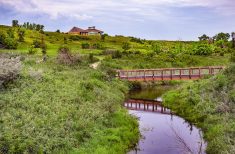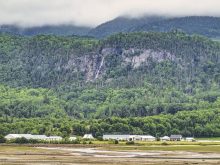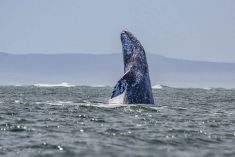In many places along New Brunswick’s Bay of Fundy coastline, we could visit two dramatically different landscapes in the same place on the same day.
This huge body of water between New Brunswick and Nova Scotia is famous for having the highest tides in the world, so what you see now will look entirely different in six hours. The average difference between low and high tide worldwide is about one metre, while in the Bay of Fundy it’s as much as 16 metres — about the height of a five-story building.
The high tides are partly due to the size of the bay, about 250 kilometres long, and its unique funnel shape. The deeper we go into the funnel, the more dramatic the tide change. Then there’s the immense volume of water that surges in and out of the bay twice a day — more than the flow of all of the world’s rivers combined.
Where the coastline is shallow, we can stand at the water’s edge at high tide, then at low tide the water can be so far away that we barely see it. Near the small community of St. Martins, we wandered into vast cavernous sea caves during low tide, only to see them filled with water a few hours later. To explore this area, the most crucial information to have is a tide chart, to provide alerts to the tide levels throughout the day.
The most unusual place to experience the tidal change is Reversing Falls Rapids in the historic city of Saint John at the mouth of the Saint John River, one of the largest waterways in the Maritimes. At low tide, we visited the viewpoint at the bridge, which crosses a narrow canyon in the river. We could see a series of wild rapids, mini waterfalls, and swirling whirlpools as the powerful river travelled through the canyon on its final descent into the bay.
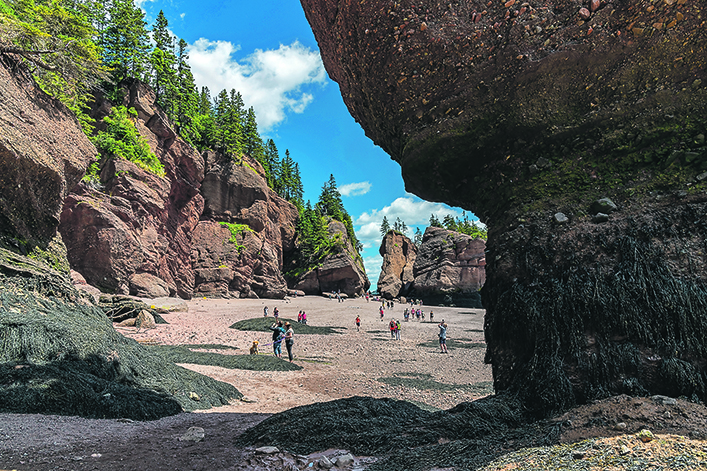
Next day we returned at high tide and again watched a series of rapids. Only this time they were going the wrong way. At Saint John, the difference in tides is around nine metres, enough to force the lower stretch of this mighty waterway to reverse its course twice a day. It’s considered the most extreme tidal effect on a river anywhere in the world.
The most impressive place to experience the tides is at Hopewell Rocks Provincial Park, deeper into the funnel shape of the bay where the tide difference is around 14 metres. Considered among New Brunswick’s top tourist attractions, the appeal is not just the tide but also the dramatic landscape. High coastal cliffs are lined by a series of sea stacks, also referred to as flowerpots. These tall conglomerate formations, often topped by a clump of trees, have eroded over the years and separated from the cliffs.

At low tide in mid-morning, we looked over the iconic scene from cliff-top viewpoints, then descended the 99 steps on a metal stairway to the ocean floor. We spent a couple of hours exploring this fairy-tale landscape of towering flowerpots, tunnels, and cavern formations. Visitors can wander on their own along a two-kilometre stretch of coastline or, as we did, take a guided tour with a park interpreter to also learn about Hopewell’s fascinating history, geology, and sea life.
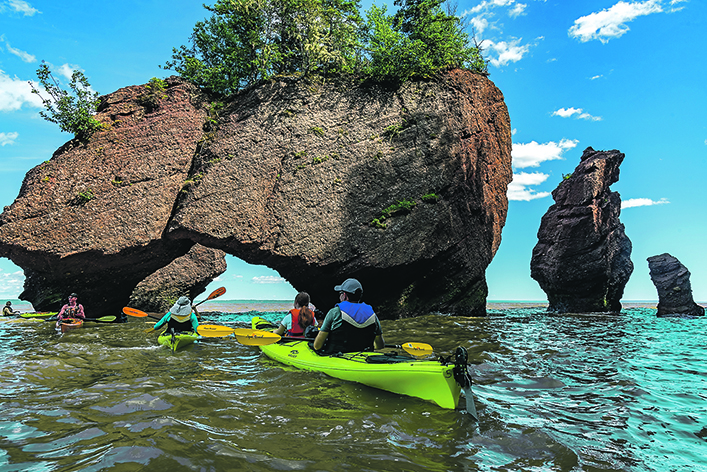
Later that afternoon at high tide we returned to the same area, this time by kayak. Guided by the folks at Baymount Adventures, we headed out into the coastal waters and soon arrived at the famous sea stacks that we had walked past just a few hours before. Now only their tops were visible above the water as we paddled amongst them, sometimes passing through tunnel-like formations. We paddled past the stairway that we took earlier, now partially underwater. It’s as if we had entered a completely different world. Here more than anywhere we get an appreciation for how the world’s largest tides can profoundly alter the landscape.
For more information, see the New Brunswick Tourism website at tourismnewbrunswick.ca.
Arlene and Robin Karpan are well-travelled writers based in Saskatoon. Contact: travel@producer.com.






